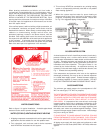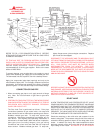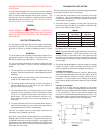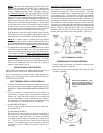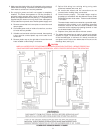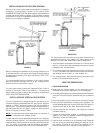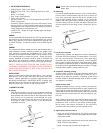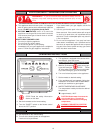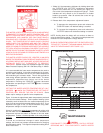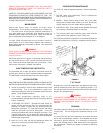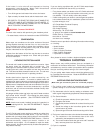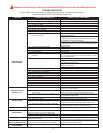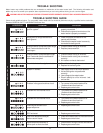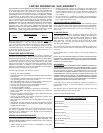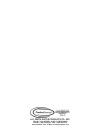
16
If the heater is to be shut off and exposed to freezing
temperatures, it must be drained. Water, if left in the tank and
allowed to freeze, will damage the heater.
• Turn off the gas and cold water inlet valve to the heater.
• Open a nearby hot water faucet and the heater drain valve.
• BE CAREFUL TO GRASP THE DRAIN VALVE HANDLE SO
THAT THE HAND IS NOT EXPOSED TO HOT WATER. IF
DESIRED, A HOSE MAY BE CONNECTED TO THE DRAIN
VALVE TO CARRY THE WATER AWAY.
WARNING: The water CAN BE HOT.
The drain valve must be left open during the shutdown period.
• To restart heater, refer to the instructions under OPERATION.
CONDENSATION
Water vapor can condense on the cooler surfaces of the tank
forming droplets, these drip into the fire or run out on the floor.
This is common at the time of startup after installation, during
periods of time when incoming water is very cold, or the heater
may be undersized for the requirements.
Droplets from the bottom of the flue may be due to corrosive
combustion products or improper vent. Check with your dealer
for more information.
CATHODIC PROTECTION-ANODE
The anode rod is used to protect the tank from corrosion. Most
hot water tanks are equipped with an anode rod. The
submerged rod sacrifices itself to protect the tank. Instead of
corroding the tank, water ions attack and eat away the anode
rod. This does not affect the water’s taste or color. The rod must
be maintained to keep the tank in operating condition.
Anode deterioration depends on water conductivity, not
necessarily water condition. A corroded or pitted anode rod
indicates high water conductivity and should be checked and/or
replaced more often than an anode rod that appears to be intact.
Replacement of a depleted anode rod can extend the life of your
water heater. Inspection should be conducted by a qualified
technician, and at a minimum should be checked annually after
the warranty period.
A hydrogen sulfide (rotten egg) odor may result if water contains
high sulfate and/or minerals. Chlorinating the water supply
should minimize the problem. (See EXTENDED NON-USE
PERIODS).
NOTE: Anode must remain installed (except for inspection) to
avoid shortening tank life. See LIMITED WARRANTY. Replace
as necessary.
SERVICE AND REPAIR
The A.O. Smith water heater requires no special care other than
the normal maintenance as noted above. If you are having a
problem with your water heater, before calling for service please
refer to the following TROUBLESHOOTING sections. If service
becomes necessary, contact your dealer, installer or an
authorized service agent. Do not attempt to repair the water
heater yourself. Any work performed by unauthorized personnel
may void the warranty.
If you are having a problem with your A.O. Smith water heater
and are not pleased with the service you received:
• First, please contact your dealer or the A.O. Smith authorized
service agent in your area and explain to them why you are
not satisfied. This will usually correct the problem.
• If after working with your dealer or service agent the problem
has not been resolved to your satisfaction, please let us know
by either writing to us at:
A.O. Smith Water Products Company
Service Department
500 Lindahl Parkway
Ashland City, TN 37015-1299
or, going to our website at: www.hotwater.com
Please click on: "Contact us",
then click on: "Service"
and leave us a message.
Please be sure to provide the following information when writing
or e-mailing:
• Model Number
• Serial Number
• Date of Original Purchase
• Date Problem Originated
• Explanation of Problem
Also, please be sure to include a daytime telephone number.
TROUBLE SHOOTING
Water heater may exhibit problems that are unrelated to a
malfunction of the water heater itself. The following information
and tables may serve to answer your question about a problem
that you are having without having to call a service agent.
For your safety, water heater service should be performed only
by a qualified service technician. Read the GENERAL SAFETY
INFORMATION section first.
WATER HEATING IGNITION SEQUENCE
(Make sure gas and electric power are connected properly)
1) The ignition control module is powered and monitors the
system, waiting for a call for heat from the thermostat.
2) The thermostat calls for heat by reading a resistance value
within a given range directly proportional to water temperature.
3) The Control Module:
a) Check the pressure switches for an open circuit.
b) Energizes the blower.
c) Checks the pressure switches for a closed circuit to prove
draft.
d) Sends line voltage to the hot surface igniter with a 20-
second warm up period.
e) Opens the gas valve and check the sensing rod for flame.
4) The burner heats the water to the desired thermostat setting.
a) The resistance in the thermostat rises to the value
selected by the temperature control knob.
b) The control module closes the gas valve and 5 seconds
later, removes power from the blower.
5) Cycle is completed.



